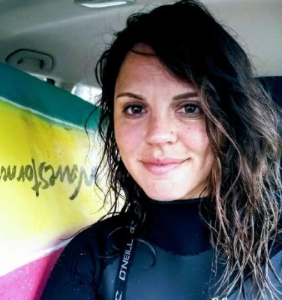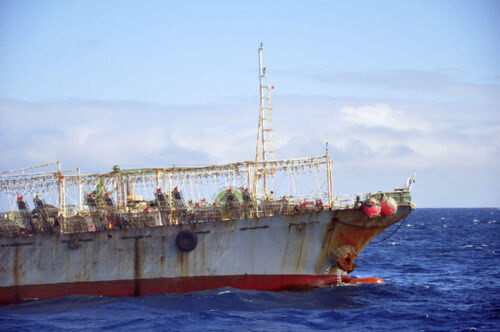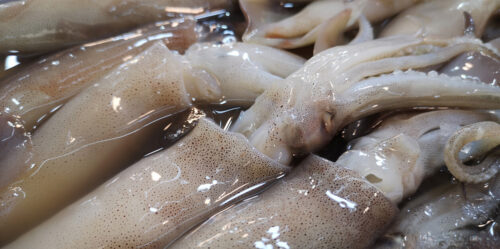A key goal of Global Fishing Watch is to partner with leading researchers who can help us better understand, apply, and expand the usefulness of our data for fisheries transparency. To date, we have partnered with over 12 academic institutions, as well as several government fisheries research agencies, such as Japan’s Fisheries Research Agency.

 Heather Welch (M.S.) and Elliott Hazen (PhD) are researchers with the Environmental Research Division (ERD) of the National Oceanic and Atmospheric Administration (NOAA)’s Southwest Fisheries Science Center (SWFSC) in Monterey, California, where they study environmental influences on marine resources.
Heather Welch (M.S.) and Elliott Hazen (PhD) are researchers with the Environmental Research Division (ERD) of the National Oceanic and Atmospheric Administration (NOAA)’s Southwest Fisheries Science Center (SWFSC) in Monterey, California, where they study environmental influences on marine resources.
Ms. Welch and Dr. Hazen are experts in modeling complex ocean processes and have published over 140 articles in leading scientific journals. They have also led the development of NOAA’s EcoCast tool, an online fisheries sustainability tool that helps fishers and managers allocate fishing effort to maintain target catch levels while minimizing bycatch of protected or threatened species. In September of 2019, Global Fishing Watch was fortunate enough to begin a collaboration with Heather and Elliott to better understand potential drivers of suspicious fishing behaviors, such as when vessels turn off their AIS. We recently sat down with these collaborators to learn more about their background and why they’re excited to be working with Global Fishing Watch (GFW).
Q: What inspired you to make a career of studying the oceans?
- Heather Welch (HW). As a kid I spent summers in Maine, which has a tidal range of about 20 feet, the largest on the U.S. east coast. Going to “low tide” was a regular family event. Armed with a bucket and a mask, I’d explore the exposed ocean floor at peak low tide and was enthralled by what I found there. These benthic safaris made me the marine scientist I am today.
- Elliott Hazen (EH). And for me, I was spending the summer along the coast of North Carolina, watching seabirds and mammals foraging on large schools of fish. Realizing how much happens under the surface of the ocean really piqued my interest into trying to understand how the ocean works. I also was fortunate to spend a semester at the Duke Marine Lab that opened up my eyes to the fact that I could make a career out of my passion.
Q: What do you see as the biggest challenges to sustainable/effective ocean management?
- HW. Measuring impact. We have powerful computers, sophisticated models, and high quality datasets that allow us to design innovative tools for ocean management. But it is really hard to quantify how well these tools work, and what difference or impact they make.
- EH. I would say that shifting ocean conditions and difficult tradeoffs are the biggest issues to sustainability. I agree completely with Heather that the technological and data revolution has been hugely transformative, but how can we be proactive for future shifts and make sure that we are meeting the needs of multiple ocean users at the same time.
Q: You work for NOAA at the Southwest Fisheries Science Center (SWFSC). How does working with Global Fishing Watch help further the mission of the SWFSC?
- HW. Combating Illegal, Unregulated, and Unreported (IUU) fishing is a central component of NOAA’s mission. This collaboration directly addresses the interests of NOAA leadership.
- EH. Artificial intelligence and big data are another part of NOAA and in turn the SWFSC’s strategic plan. This work has the potential to show how we can harness the large amount of GFW data to help combat IUU fishing.
Q: A key element of your work is modeling marine species distributions. What are the objectives of this work and why is it challenging? What types of data are important?
- HW. Species distribution models primarily help us do two things: 1) explain why we see species in certain places and not others, and 2) predict where species are going to be outside of places and times where we’ve observed them in the past. These models rely on long-term datasets of species observations, which are collected using a variety of methods such as satellite tags, shipboard surveys, and aerial surveys, as well as time-series of environmental data, for example satellite imagery. Outputs from species distribution models can help us make decisions about where, when, and how to best manage species of concern. But interpreting these models and translating them into management tools requires careful consideration and validation. Statistician George Box stated “all models are wrong, but some are useful,” and one of our goals is to figure out where the threshold lies in terms of usefulness for management.
- EH. Species distribution models rely on a strong relationship between what you are trying to model (fish, fishing vessels, etc.) and the environment. One of my big concerns is that these relationships may change in the future with increased climate variability and change. Thus, exploring approaches that constantly re-fit the data (similar to data-assimilative oceanographic models) may become an important research area in the future.
Q: You highlight dynamic management as an important fisheries management strategy. What is dynamic management and how can Global Fishing Watch be informative?
- HW. In contrast to static management strategies like Marine Protected Areas, dynamic management strategies have boundaries that update regularly in response to changing ocean conditions, animal movement, and human activities. This flexibility is particularly useful for managing the movements of highly migratory species and fishing fleets. Dynamic strategies require that input data are updated in near real-time, making the data produced by GFW particularly amenable to dynamic management.
- EH. With changing conditions, we need tools that can respond quickly and minimize unexpected risks while maximizing sustainable uses of the ocean. Dynamic ocean management is just one example of this kind of tool, and fisheries have been one area where dynamic ocean management has been broadly applied.
Q: What is the value of open-source data like that of Global Fishing Watch?
- EH. GFW data are incredibly useful in shining a spotlight on activity particularly in the open seas. Because these data are near-real-time, they are particularly useful in informing dynamic ocean management approaches to improve fisheries sustainability.
- HW. Open-source data are critical to develop operational tools, such as dynamic management strategies. These tools are designed to operate indefinitely into the future, and therefore the data they rely on must also be available indefinitely into the future. This makes it infeasible to use private data that must be purchased, as long term tool operations are often unfunded. Open-source data ensures that tools can continue to operate without funding constraints.
Q: What are you currently working on with Global Fishing Watch and how has GFW changed your work?
- HW. We are currently partnering with GFW to use machine learning to understand where and why vessels intentionally disable their AIS devices. We recently received a grant from NOAA’s Office of Law Enforcement, which will allow us to expand on this work to develop a near real-time prediction system for potentially nefarious activities like intentional disabling of AIS and unauthorized transshipments. We will also develop near real-time predictions for key shark and tuna species, allowing us to identify which species are more likely to be involved in unauthorized transshipments and which species are most likely being fished for in the areas where vessels disable their tracking devices.
- EH. I have spent a large part of my career modeling how marine species respond to oceanography because we have had difficulty measuring their prey resources at the appropriate scales. Similarly, we model the species because we may not understand how the fisheries are responding to changes in the ocean. GFW has provided a unique and game-changing dataset on fishing activity that can support new tools for advancing our basic understanding of how people use the oceans, but also for management and enforcement to ensure that illegal activity is not threatening our fishery resources.
Tyler Clavelle is a data scientist at Global Fishing Watch.


